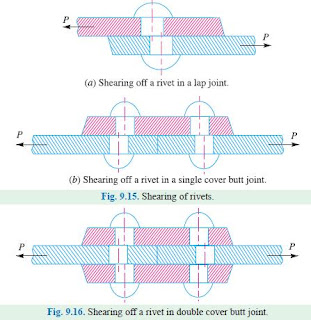failure of a rivet joints
Rivet
Rivets are short ductile and cylindrical bars that are used for making a permanent mechanical joint. The process of forming a riveted joint is called riveting. A rivet is divided into 3 parts i.e., the head at one end, the tapered tail, and shank,
The portion between the head and tail as shown in the figure.
As it is a permanent joint it cannot be disassembled without the failure of the machine component. The material of rivet should be tough and ductile.
They are usually made of low carbon steel, nickel steel,
Brass, Aluminum, copper, etc.
Physics Behind Rivetting.
The main function of a rivet is to make a connection,
That has the strength to prevent failure and tightness to prevent leakage.
For connecting “> 2 metal plates, firstly holes are punched and reamed. The plates are then separated to remove any burrs or chips. The cylindrical cold or red-hot rivet is then inserted into the hole. Then the head is backed by a hammer or heavy bar and then the
Die as shown in the figure and is placed against the end to be headed,
And the blows are applied by a hammer.
Force applied causes the shank to expand and fill the gap. The force applied deforms the tail plastically and forms the required shape. As the rivet cools down, it contracts. But the lateral contraction is slight and there will be longitudinal tension which holds the plates firmly together.
TYPES OF RIVET HEADS
Rivethead is classified into 3 broad categories:
TYPE OF RIVET JOINTS
Rivet joint is classified into 2 types depending on the way in
Which the plates are connected.
Lap joint:
A lap joint is one in which one plate overlaps the other,
And the two plates are then riveted together.
Butt-joint:
A butt joint is that in which the main plates are
Kept in alignment with each other and a cover plate (called strap)
It is placed either on one side or on both sides of the main plates.
The cover plate is then riveted together with the main plates.
The butt joint is further dived in 2 types:
- Single strap butt joint
- Double strap butt joint
The edges of the main plates are placed against each other and
Only one cover plate is placed on one side of the main plates and then riveted together.
The edges of the main plates are placed against each other and
Two cover plates are placed on both sides of the main plates and then riveted together.
In addition to above, depending on the number of rows of the rivets
They are classified as single riveted joint,
Double riveted, triple, quadruple and chain riveted joints.
TERMS USED IN RIVETED JOINTS
- Pitch: It is the distance from the centre of one rivet to the centre of the next rivet measured parallel to the seam. It is usually denoted by p.
- Back pitch: It is the perpendicular distance between the centre lines of the successive rows. It is usually denoted by PB.
- Diagonal pitch: It is the distance between the centers of the rivets in adjacent rows of zigzag riveted joints. It is usually denoted by PB.
- Margin or marginal pitch: It is the distance between the centres of rivet hole to the nearest edge of the plate. It is denoted by m.
FAILURES OF RIVETED JOINT
Riveted joint may fail in various ways:
- Tearing of plate at an edge
A joint may fail due to the tearing of the plate at an edge.
And this can be avoided by keeping the margin, m = 1.5d,
Where d is the diameter of the rivet hole.
Tearing of plate across the rows of rivets
Due to the tensile stresses in the main plates,
The main plate or cover plates may tear off across a row of rivets.
In such cases, we consider only one pitch length of the plate,
Since every rivet is responsible for that much length of the plate only.
- Shearing of rivets
The plates which are connected by the rivets exert tensile stress on the rivets,
And when the rivets are unable to resist the stress, they shear off.
- Crushing of rivets
Sometimes, the rivets do not shear off under the tensile stress,
But are crushed. Due to this, the rivet hole becomes oval and hence the joint becomes loose.






Nice
ReplyDelete